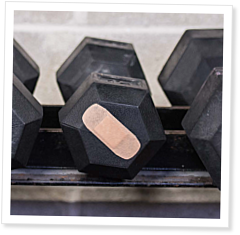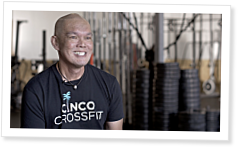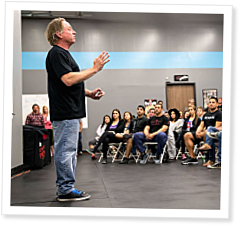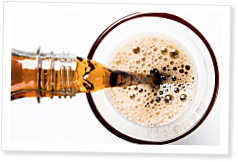by Mark Rippetoe
“Training is not about today. It is about the process of going from where you are now to here you want to be later, for the purpose of meeting a specific performance goal. . . During a training cycle, each individual workout is important only because of its place in the whole process.”
[A version of this article originally appeared on T-Nation, 4-14-2013]
Read More
var addthis_config = {"data_track_addressbar":true};
Training is not about today. It is about the process of going from where you are now to here you want to be later, for the purpose of meeting a specific performance goal. . . During a training cycle, each individual workout is important only because of its place in the whole process.
If strength is the objective (and it should be for everybody), understanding the difference between training and exercising is fundamental to being an effective athlete and an effective coach. So is understanding the difference between the basic barbell movements – the primary exercises – and the assistance exercises, the ones most people worry the most about.What is the difference between an effective strength coach and a physical therapist pretending to be a strength coach? What is the difference between a lifter who gets big and strong and the gym rat who’s been the same skinny kid for the past three years? What is the difference between a frustrated P90Xer/CrossFitter and a successful strength athlete? What is the difference between a productive trainer and a personal trainer that is, in actuality, a paid babysitter/rep counter and paid friend for those who can afford her?In each of these four examples, the former understand the difference between the primary exercises and the assistance exercises; they understand what the primary and assistance exercise are used and how they are programmed. In each of the four examples, the latter – the physical therapist, the gym rat, the fad trainer and the highly paid ineffective personal trainer – doesn’t have a clue. The former structure their training around primary exercises and program them, the primary exercises, for long-term progress, using assistance exercises only when progress has slowed on the primary exercises.The ill-informed think that variety is the objective and that boredom is the enemy, that the pump, sweat, fatigue, and soreness are the hallmarks and the objective of an effective workout, not realizing that these things are just the side-effects of what happened today, and are not the indicators of progress. The uninformed don’t understand that athletes getting stronger are not bore-able, that measurable increases in the weight used on the basic exercises is required, and that the inclusion of new “moves” in every workout – exercises that inherently lack the ability to drive basic strength – does not accomplish one single solitary thing if strength is the objective. They lose sight of the fact that “muscle confusion” is a rather odd concept, and that doing dozens of different exercises actually prevents productive training for strength acquisition. This is the nuts-and-bolts difference between effective strength training and wasting time and potential.How many times have you seen the following:
Magazine articles about the variety of exercises available for “doing arms,” “legs,” “back,” “abs,” or, worst of all, “The Core.” The fucking Core. The thing that’s always stronger on a man with a 500 squat.
Infomercials for weight loss or “ab” development programs that emphasize the number of exercises available to accomplish this miraculous transformation.
New York Times pieces about the new “moves” (exercises) for 2013 for firming and toning your abs/inner thighs/outer thighs/arms/neck/“sidemeat”/“Buttissimo.”
Books written by Physical Therapists that detail the different exercises that are absolutely necessary to strengthen your Core. All of them, absolutely necessary, none of them programmable for improvement for 6 months, or even 6 weeks. Because they can’t be.
Successful lifters, bodybuilders, and strength athletes all share one thing in common: their training is based around six or seven basic barbell movements, and the variables that are manipulated are volume, intensity, and rest, NOT the number of exercises. Because there aren’t very many exercises that can actually be trained.First, “Training” and “Exercise” are different things entirely. Training is the process of directed physical stress which results in an adaptation that satisfies a performance goal. Since different performances require different physical abilities, and different tasks produce different types of stress, and since stress causes an adaptation (if you can recover from it), therefore different physical abilities are acquired by doing different physical tasks, and the training stresses that facilitate these different adaptations must be specific to the performance goal being trained for. Duh, right?Exercise ignores this fact. Exercise is what happens when you go to the gym and do exactly the same thing you did last time you went to the gym, or when you do P90X, CrossFit, or any other randomized program. These activities are performed for one reason: the effect they produce for you today, right now. Fucking around in the gym is merely punching the ticket – you showed up, moved some stuff around, got sweaty, tired, and maybe out of breath, but you did the same thing Friday as you did Wednesday, and now that you think of it, the same thing you did Monday. The harder programs like CrossFit and P90X are about the “burn,” the sweat, the heart rate, the feeling of being “gassed” or “thrashed” or “fried” or “crushed” – they are about the perceived physical effects of the workout as or immediately after the exercises are performed. The random nature of the exercises ensures that you will be “crushed” every time, because it guarantees that you will not adapt to the work. Either way, they are really about what happens today.Training is not about today. It is about the process of going from where you are now to here you want to be later, for the purpose of meeting a specific performance goal – usually at a specific time for more advanced trainees on a competitive schedule, but at first for the simple purpose of completing the novice phase of training, the first few months when it’s easier to add weight every workout and get strong very quickly. During a training cycle, each individual workout is important only because of its place in the whole process. Subjective judgements about how the workout felt are important only to the extent that they provide information that would make the next workout better. Much more important is this basic question: Did you meet your numbers on the squat, press, and deadlift today? {pagebreak}Training cannot be accomplished randomly, because randomly applied stresses do not create a specific adaptation. For example, squatting 5 sets of 5 once every 3 to 5 weeks, or whenever Pukie posts it, does not apply a stress that can be adapted to – and built upon – before detraining to the stress occurs. This is especially true if during the intervening period many other stresses have been applied that conflict with the adaptation necessary to get better at squatting heavier sets of 5 – doing hundreds of reps of unweighted squats, for example. Or doing hundreds of reps of anything, if the performance goal is doing 5 reps or 1 rep with a very heavy weight. Or doing nothing at all, which in itself is a stress that will be adapted to.Since Training is a process designed to produce an adaptation, this process necessarily entails more than a short period of time, because the adaptations that are necessary for high-level performance take time to accomplish. Strength, for example, can be improved for many years if the processes that produce it can be continued uninterrupted by injury or distraction. The closer you get to your genetic potential for any given adaptation for performance, the slower the progress will be and the more critical the method by which the stress is applied will become. This is merely the principle of diminishing returns, whereby a value approaches a limit asymptotically, and is in evidence all throughout the universe.It must be said that not everybody is interested in Training. For lots of people, Exercise is good enough. They just want to burn some calories, get a little conditioning work, and have better abs. This is fine, for these people. But the second you want more – when you decide that there will now be a goal to accomplish with all this gym time – you have graduated to Training.
Now that you’re all grown up, which exercises will you use to get there? Considering our previous analysis, you’ll need to choose movements that have the capacity to produce the desired adaptation over the long timeframe that profound, transformative adaptation requires. If you’re a runner, you’ll run; a swimmer, you’ll swim. After your initial novice phase, where the gains come quickly, you’ll vary your workloads by manipulating volume and intensity over longer periods of time. If you’re a smart runner or swimmer, you’ll add some strength training to the program to help with force production, but running and swimming will still be the primary tools you rely on to improve at running and swimming.Lifters, bodybuilders, and strength athletes often lose sight of the fact that they are really in the same situation. For us, heavy work on squats, deadlifts, bench presses, presses, power cleans and snatches, and leg presses and maybe barbell rows for bodybuilders, will comprise the vast majority of the productive effort we will expend throughout our training careers. Basic barbell training will be the foundation of our progress for the entirety of our gym lives, and all the other work we do – the assistance work – must be kept in the proper perspective.The primary lifts and the assistance exercises differ in one very important respect: the primary exercises can be trained and improved for years at a time, if the aforementioned injuries and distractions do not occur. The assistance exercises cannot. This is obviously due to the fact that the primary exercises are systemic in nature – they inherently affect the entire body because the entire body is involved in the exercise. Squats, presses, and deadlifts produce enough stress to induce hormonal changes and structural adaptations system-wide. These fundamental movements all have a kinetic chain that starts at the floor and ends with the bar in the hands. The arms are not in the kinetic chain of the squat because they do not move the bar, but they stabilize the weight. The bench press is the only primary exercise with a short kinetic chain (the legs not being a part of the kinetic aspect of the exercise, even though they are critical to benching heavy weights), but it includes enough muscle mass to meet the criteria by being able to improve throughout the lifter’s training career, if care is taken to balance it with the press so that the shoulders stay healthy.Assistance exercises use less muscle mass, a short kinetic chain, or are some variant of the parent exercise that is less efficient at allowing as much weight to be lifted. In my book, Starting Strength: Basic Barbell Training 3rd Edition, I categorize these exercises as either assistance exercises, which are variations on the parent exercise, like stiff-legged deadlifts, RDLs, close-grip benches, and low-box squats, or ancillary exercises, which work a group of muscles in a way that the primary exercises do not, like a chin-up or a back extension.Partial movements, like rack pulls, partial benches, and presses that use heavier weights through a shorter portion of the ROM of the parent exercise, can be improved right alongside their parent exercises, and can be used to drive progress for as long as they are trained. But they do not constitute a replacement for the parent exercise; rather, they are used to drive continued progress on the primary lifts for more advanced trainees. My comments in this article refer to exercises that are designed to train a muscle group, not a movement pattern. Ancillary exercises like curls, wrist curls, seated curls, preacher curls, dumbbell curls, dumbbell preacher curls, dumbbell front raises, dumbbell lateral raises, dumbbell flyes, anything done on one leg or with one hand, and 1615 or so of the 1621 exercises described in Bill Pearl’s Keys to the Inner Universe do not qualify as basic exercises, because they cannot be Trained for long-term progress – they can only be Exercised.One more thing: all the basic barbell exercises can be assessed with a one-rep maximum effort. This doesn’t mean that they should be tested for 1RM – it just means that they can be. Novices have a new 1RM every workout, since they are getting stronger every workout by doing sets of 5, and 1RM testing is pointless for novices. Probably for intermediates too, since they are still getting stronger every week. In contrast, assistance exercises cannot effectively be done for 1RM. Imagine a 1RM dumbbell fly, a 1RM wrist curl, or even a 1RM RDL, and you can easily see my point. These exercises are designed to be used for higher reps because they are designed to work a muscle group, and a 1RM test applied to an isolated muscle group is an excellent way to get very injured.{pagebreak}Most machines are designed to exercise a muscle group. So, all muscle group machines are automatically optional as hell. All the others are designed to mimic a barbell exercise, but to remove the balance component of the movement. Hammer Strength makes lots of these things. I think it is important to be able to fall down when you do a barbell exercise, so that you have to make sure you don’t. The balance aspects of the movement are critical to the training effect, and when this is removed you are left with a Glorified Exercise. Leg presses are a good example of a Glorified Exercise, but I’ll admit that some bodybuilders have used them successfully to build a massive pair of legs. I wonder how much they can squat. (It has always been my observation that a guy with a big squat has a big leg press, but that the converse is never true.)Likewise, bodyweight-only exercises like situps, pushups, burpees, air squats, one-legged squats, handstand pushups, bodyweight dips, exercises done on rings, and kettlebell exercises – any exercise whose loading variable is the number of reps or the length of the set, and which does not have a 1RM – cannot drive a strength improvement. This is because after about 10 reps, and depending on your bodyweight, they are not limited by your force production ability; they are endurance exercises. Their repetitive nature means that they are inherently sub-maximal in terms of force production. They cannot make you stronger unless you are very weak, and they cannot continue to make you stronger for more than a couple of weeks even if you are.Look in your notebook and ask yourself this question: How long have you been able to add weight on a weekly or even monthly basis to your back extensions? Your tricep work? Your situps, curls, lunges, dumbbell rows, and behind-the-neck lat pulldowns? Can you swing a set of 5 with a 300-pound kettlebell? And if you can, what made you that strong, kettlebells or squats? Even very useful ancillary movements such as chins have a limited ability to continue to strengthen for long periods of time. And none of them get strong for as long as your squat does.This does not mean that these exercises are not useful in the context of a correctly designed training program. But it does mean that programs based on them are not Training, for the same reason that programs that do not drive regular, programmed improvements in the primary lifts are not Training.
There are many successful “strength coaches” who have made careers out of writing programs that are actually just lists of exercises done in some way or another, that appear to work satisfactorily. The inescapable fact that many pro-level athletes get away with Exercising instead of Training is a function of elite-level genetics, not exercises posing as Training. Every professional or D1 athlete spending his time in the weight room adding to his collection of unilateral balancing tricks is wasting his potential for strength improvement, and strength is the most basic of athletic adaptations. All other aspects of performance depend on strength – this is why athletes take steroids. There are no “balance steroids” and no “agility steroids” and no “endurance steroids” and no “core steroids.” And it is why they should be squatting, pressing, and deadlifting instead of playing around with “Bulgarian Split Squats” and other such silly distractions from the real task at hand. Even Elite-level athletes who have not actively pursued a linear increase in barbell strength still have the potential to do so, and the failure to get stronger always represents wasted potential. This is especially tragic if that failure is the result of following the advice of a “strength coach” who doesn’t really know how to increase an athlete’s strength. Catching up will always involve squats, presses, benches, and deadlifts, and may also involve getting another strength coach.Look around your gym and count the guys who are just exercising. They’re physically quite easy to spot: they are neither big nor strong. What are they doing – full squats and deadlifts, or standing in front of the dumbbell rack? Are they standing with heavy barbells in their hands, or sitting with dumbbells in their laps? Where has most of their time been spent in today’s workout, on one foot or two, in a balanced symmetrical stance or staggered in some version of a split? How many have a training log, and how many of these guys are writing down all the exercises they just did instead of referring to what their log tells them they are supposed to do today?History tells us what works in the gym, and everything else walks down the road with a carrot in its ass. Guys that have spent their careers in the gym know what works and what doesn’t, if the focus of their practice has been demonstrable improvement in strength for everybody that comes through the door. Training results in long-term progress in a specific direction, while Exercise gets you tired and sweaty, satisfying the desire for a feeling of accomplishment for people who are easily satisfied. Training utilizes loaded movements that have the ability to generate long-term progress – squats, presses, bench presses, deadlifts – and Exercise can use any damn thing it wants to, because Exercise doesn’t care about the long term, it just cares about today. Basic heavy barbell movements are what the strongest, biggest men of the past century have used to get that way. Assistance exercises are merely the things these men do in the gym after they have Trained, while they are resting. Quit wasting time and start training the basic lifts, and save the assistance exercises for later. If there’s time.
























